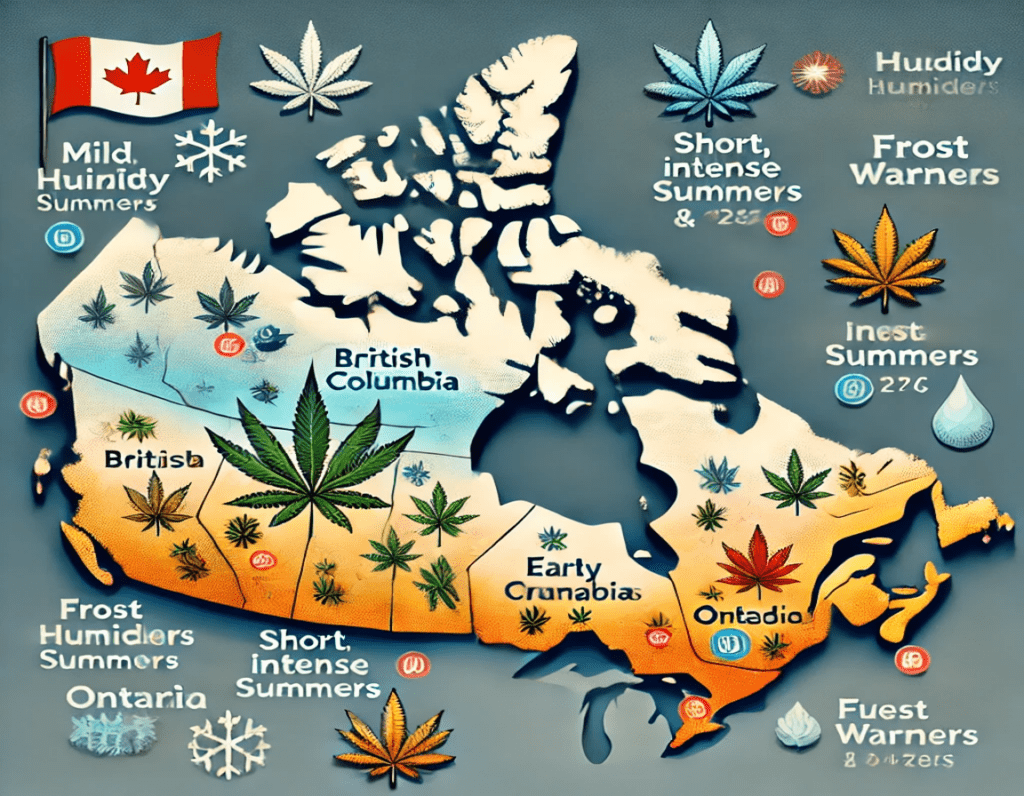
Canada’s vast geography presents a range of climate challenges for growing Cookies Seeds. From the mild, rainy conditions in British Columbia to the short, intense summers in the Prairies, each region demands different strategies. In the Pacific Northwest, growers must manage high humidity, which can promote mold, while those in the Prairies face early frosts and shorter growing seasons. Ontario and Quebec have warm summers but cold winters, making it essential to optimize sunlight and protect against sudden temperature drops. Understanding your local climate is key to adapting your growing practices for the best results, and using real-time weather data can help you navigate the growing season more effectively.
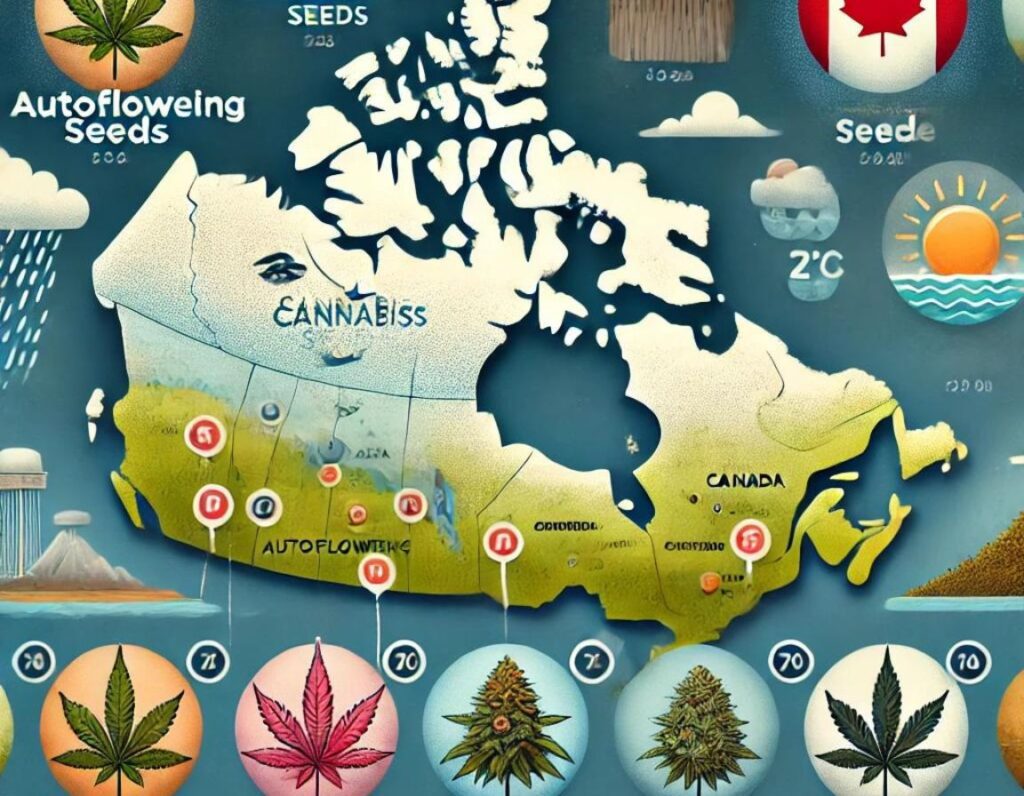
Cookies Seeds are popular for their unique flavor and high THC content, but choosing the right variety for your region is crucial to success. In colder northern regions like the Prairies or Northern Ontario, look for Cookies varieties that are known for their hardiness and shorter flowering times. Autoflowering Cookies strains are an excellent choice for these regions, as they have quicker growth cycles and don’t rely on specific light conditions to flower. This means you can harvest your crop before the first frost hits.
For regions like British Columbia or the Maritimes, where humidity is a major concern, mold-resistant Cookies strains are a better fit. Look for varieties that are naturally resilient against high moisture levels, reducing the risk of mold and mildew ruining your harvest. These strains thrive in the wet, coastal air but still need some protection from sudden weather changes.
The right Cookies variety can make or break your yield, so research which strains have been successful in Canadian gardens similar to yours. Check real-time seed availability from trusted sources to find varieties that are already adapted to Canadian conditions, ensuring you’re starting with a strong foundation.
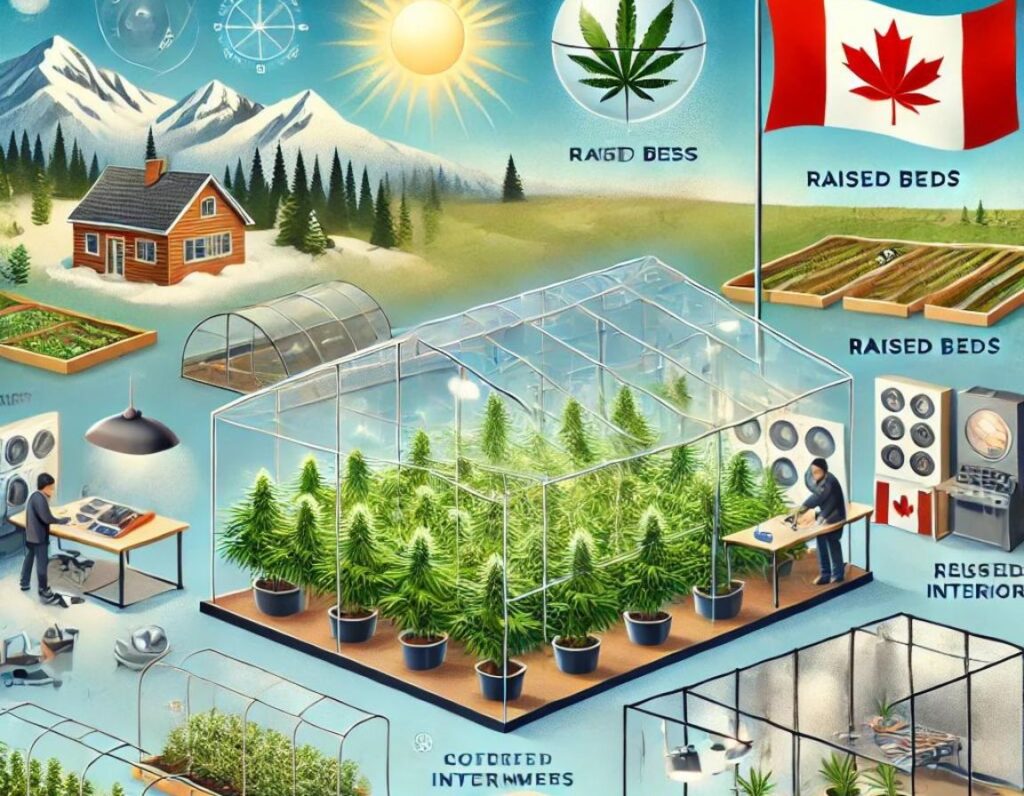
For growers looking to extend the growing season or even grow year-round, greenhouses are an excellent solution, particularly in colder regions. Greenhouses offer protection from harsh weather conditions, help control temperature and humidity, and shield plants from pests. In areas like the Prairies or Northern Canada, where frost arrives early, greenhouses can create a controlled environment that mimics milder climates, allowing for extended growth cycles. Consider incorporating supplemental lighting and heating to maintain optimal conditions, even during cold Canadian winters.
Nutrient management is key to ensuring the best yield from your Cookies seeds. Canadian soil quality can vary greatly depending on your location. Coastal regions may have more acidic soils, while central regions like the Prairies often have clay-heavy or alkaline soil. Testing your soil’s pH and nutrient levels will help you determine which amendments are necessary. Canadian growers often need to supplement with nitrogen, phosphorus, and potassium to meet cannabis’s high nutrient demands, particularly in areas where soil lacks natural fertility.
Canadian summers are often brief, and many regions face a tight window for outdoor growing. One way to adapt to this is by selecting fast-flowering or autoflowering strains. However, even with these strains, strategic planting is crucial. Consider starting your seeds indoors or in a greenhouse in early spring, then transplanting them outdoors when the risk of frost has passed. Additionally, utilizing techniques like light deprivation can trick plants into flowering earlier, ensuring a harvest before the cold weather sets in.
Watering your Cookies seeds appropriately is essential, especially in regions with unpredictable rainfall. For regions with frequent rain, such as the coastal areas of British Columbia or the Maritimes, it’s important to prevent overwatering, which can lead to root rot. Using well-draining soil and raised beds can help avoid waterlogged roots. In drier areas like the Prairies, where rainfall can be scarce, employing drip irrigation systems or mulching around the base of the plant helps conserve water and keep the roots moist without excessive watering.
Indoor growers in Canada have the advantage of controlling their environment, especially when it comes to light cycles. Cookies strains tend to thrive with longer light exposure during the vegetative stage and reduced light during flowering. In regions with short daylight hours in winter, using high-quality grow lights is essential. Full-spectrum LED lights mimic the natural light conditions necessary for cannabis growth and are energy-efficient, making them a great option for Canadian indoor growers looking to reduce their electricity costs

Canada’s growing season is shorter compared to many other countries, so maximizing your Cookies seeds’ growth potential is crucial. This involves closely monitoring the weather and adjusting your growing practices accordingly. The growing season typically ranges from May to September, though this can vary significantly depending on your region. Real-time weather updates can be invaluable in this regard.
To make the most of Canada’s shorter summers, time your planting to coincide with the last frost of the season. In most southern regions, this occurs in mid-May, while northern regions may need to wait until early June. Once your plants are established, maximize sunlight exposure by ensuring they are in a location that receives at least 6-8 hours of direct sunlight daily.
Watering practices should also be adjusted to match local weather patterns. For example, growers in the Prairie provinces may need to water more frequently due to drier conditions, while those on the West Coast should be mindful of overwatering due to high rainfall levels. Regular monitoring of moisture levels in the soil, combined with local weather data, can help you avoid common issues like root rot or dehydration.
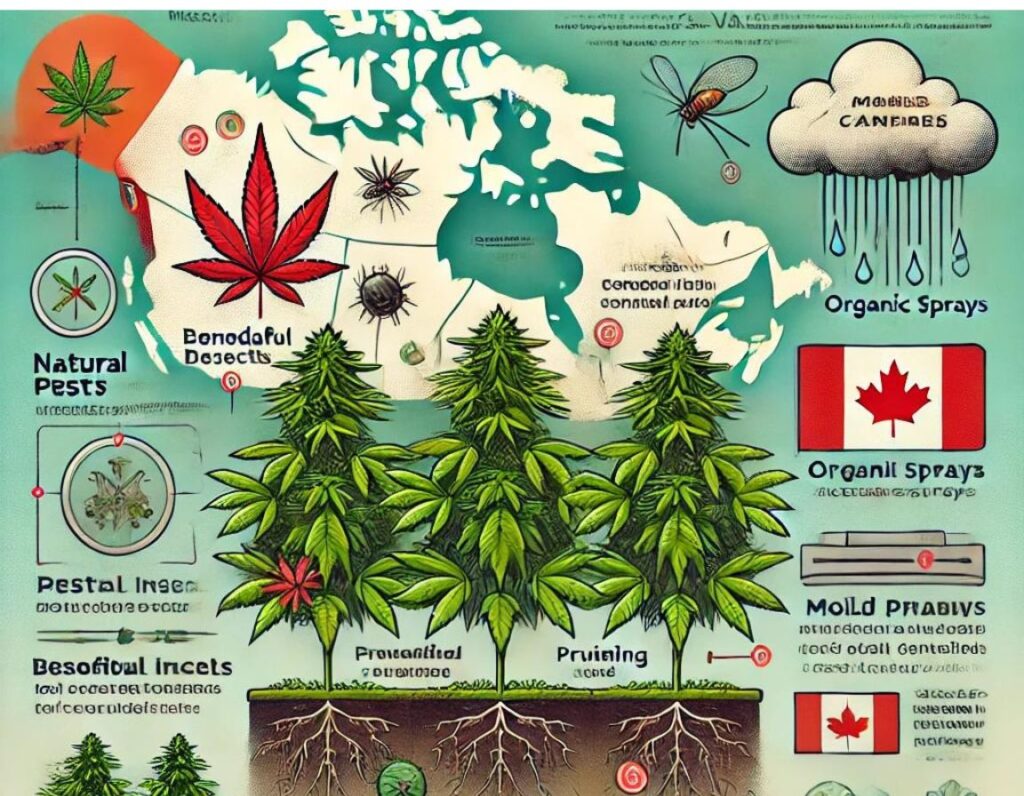
Canada’s varying climates create different challenges when it comes to pests and mold. In more humid areas like the Pacific coast and Atlantic Canada, mold and mildew can be significant concerns, particularly in outdoor grows. Monitoring humidity levels and using preventive measures like pruning for airflow or applying organic fungicides can help reduce the risk.
In drier regions like the Prairies, pests such as aphids, spider mites, and caterpillars can pose a problem. Natural pest control methods, such as introducing beneficial insects or using neem oil, are effective and eco-friendly options for protecting your plants. Growers should stay vigilant, checking plants regularly for signs of infestation or disease.
For mold-prone areas, reducing plant density, improving air circulation, and removing excess moisture from the air can help prevent mold outbreaks. If you notice signs of mold on your plants, immediate action is necessary to prevent it from spreading. Regular inspections combined with the right preventative measures will ensure that your Cookies plants remain healthy throughout the growing season.
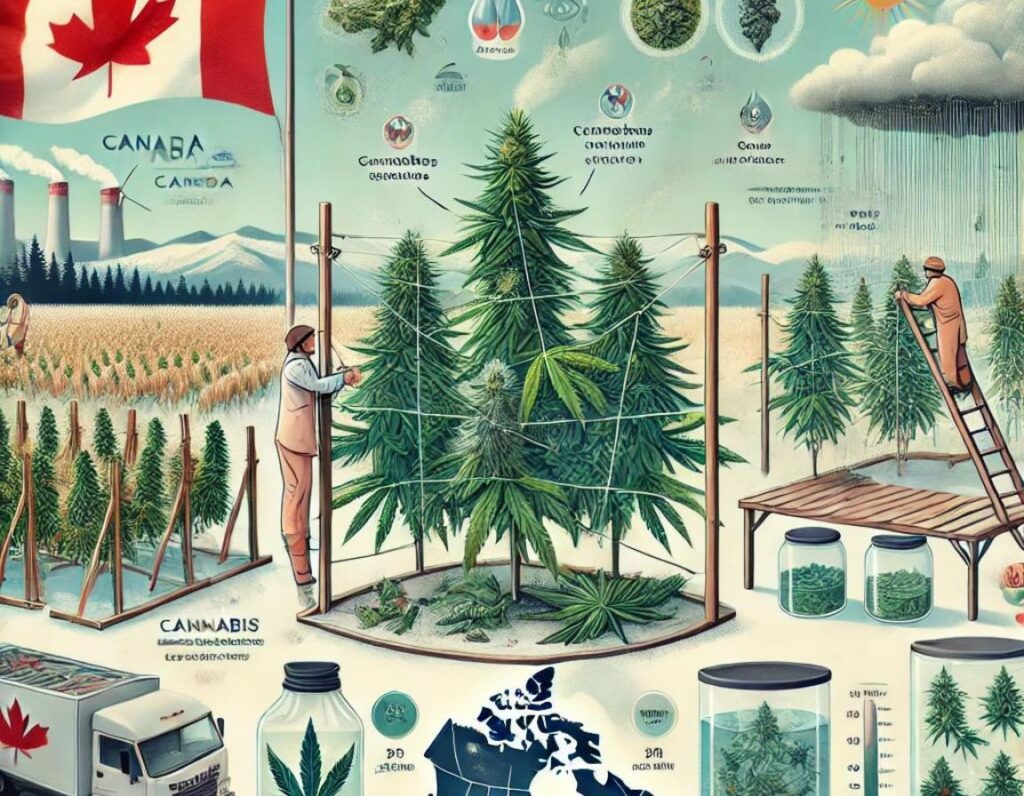
Timing your harvest is critical in Canada, especially in areas with unpredictable weather. The goal is to harvest your Cookies seeds at the peak of potency, which often coincides with the first frost. In regions with shorter growing seasons, autoflowering strains may mature more quickly, allowing you to harvest before cold weather sets in.
Once harvested, drying and curing your plants properly is essential to preserve their flavor and potency. In humid climates, use dehumidifiers or well-ventilated drying spaces to reduce moisture in the air, preventing mold from developing on your buds. In colder, drier regions, take care not to overdry your product, as this can lead to a loss of potency.
The curing process is where your Cookies plants develop their signature aroma and taste. For Canadian growers, the drying phase may take longer due to cooler temperatures, so patience is key. After drying, store your buds in an airtight container, periodically opening it to release excess moisture until they are fully cured.
Autoflowering strains are recommended for colder regions as they have shorter flowering times, allowing you to harvest before frost arrives.
Yes, depending on your region. Warmer areas like southern Ontario or British Columbia are suitable for outdoor growing, but northern regions may require greenhouse or indoor growing to protect plants from cold weather.
Using frost covers, greenhouses, or moving plants in mobile containers indoors during cold snaps can protect them from frost damage.
Aphids, spider mites, and caterpillars are common pests in drier regions. Introducing beneficial insects or using organic pest control methods can help.
Autoflowering strains are ideal as they have shorter growth cycles. Plant after the last frost and monitor real-time weather conditions to adjust your planting schedule.
Harvesting typically occurs in late September to early October, depending on your region’s frost dates and the type of strain you’re growing.
We ship and deliver world wide via USPS and various couriers.
We offer a wide range of secure and anonymous online payment options.
We care about you, our customer. Please contact us with any questions or concerns.
Find out more about the benefits of being a loyal and regular customer.
WE ARE EVERY GROWERS ONE STOP SHOP TO ACQUIRE PREMIUM CANNABIS SEEDS FOR SALE IN THE USA, CANADA AND AUSTRALIA

Farmers Lab Seeds 2024, | All Right Reserved
Seeds are sold as novelty items, souvenirs, and collectibles. They contain 0% THC. We encourage our customers to check the legislation in their Country, State, Province, and Municipality prior to purchasing items from our store. We do not provide growing information.
All seeds are sold as hemp, and lab tested under 0.3% THC. This product is not for use by or sale to persons under the age of 21. This product should be used only as directed on the label. It should not be used if you are pregnant or nursing. Consult with a physician before use if you have a serious medical condition or use prescription medications. A Doctor’s advice should be sought before using this and any supplemental dietary product. All trademarks and copyrights are property of their respective owners and are not affiliated with nor do they endorse this product.
These statements have not been evaluated by the FDA. This product is not intended to diagnose, treat, cure or prevent any disease. Individual weight loss results will vary. By using this site, you agree to follow the Privacy Policy and all Terms & Conditions printed on this site. Void Where Prohibited by Law.